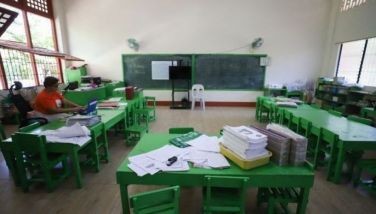VFA termination poses ‘shattering impact’ on SEA security – expert

MANILA, Philippines — The termination of the Visiting Forces Agreement (VFA) will have a “negative if not shattering impact” on regional security, as Southeast Asian countries – including the Philippines – rely on US military presence as counterweight to an aggressive China, according to an Australian defense analyst.
“ASEAN (Association of Southeast Asian Nations) members publicly and privately count on a US military presence to counter-balance China. The termination of VFA would lead to a marked reduction in US military presence, especially in the South China-West Philippine Sea,” Prof. Carlyle Thayer, defense force lecturer at Australia University of New South Wales, told reporters on the sidelines of the Singapore Airshow recently.
He also said the scrapping of the defense arrangement would have a knock-on effect on the professionalism of the Armed Forces of the Philippines (AFP) and on its interoperability with American forces.
The US Navy regularly conducts Freedom of Navigation Operations (FONOPS) in the South China Sea aimed largely at ensuring free flow of commerce in the region as well as checking China’s expansionist activities.
The VFA allowed the deployment of US forces in the Philippines on rotation basis. In return, Filipino military officers were sent to the US for professional military education and training.
With the VFA officially gone after six months, another Philippine-US defense arrangement – the Enhanced Defense Cooperation (EDCA) – will likely be the next to go.
Like the VFA, EDCA is a component of the 1951 Mutual Defense Treaty (MDT) that requires one country to come to the aid of the other in case of external attack. EDCA allows the US military to pre-position equipment and logistics at designated areas within Philippine military camps.
“It is likely the next casualty would be EDCA and ultimately the MDT,” he said, adding the termination of the VFA will have an immediate impact on this year’s more than 300 scheduled joint military exercises between US and Filipino forces in the Philippines.
Filipino and US military planners, meanwhile, said that until ordered to stop, joint drills will continue, specifically this year’s joint Balikatan exercises set from May 3 to 15.
Thayer also warned that if MDT and EDCA are likewise discontinued, the Philippines will become an “orphan” state in the region, just as it had been in the years after the removal in the 1990s of Clark Air Force Base and Subic Bay Naval Base. The two were the largest US bases outside the US mainland.
He also pointed out that the termination of the two US bases in the Philippines gave China the opportunity to occupy Panganiban (Mischief) Reef in 1995.
“Any rupture in Philippines-US relations would also undermine ASEAN unity and ASEAN’s centrality in the region’s security architecture,” Thayer said.
“I do hope that there will be a compromise between Duterte and Trump… We are deeply concerned about China’s massive militarization in the South China Sea,” Thayer stressed.
Meanwhile, the US defense department said in its 2019 last quarter report to the US Congress that the Philippines is at risk of becoming one of the major destinations of retreating Islamic State (IS) militants from the Middle East due to lack of sustained counter-terrorism efforts among regional partners and allies.
Glenn Fine, US defense department’s principal deputy inspector general, also said in the report that delays in the reconstruction of Marawi City have allowed militants to regain a foothold in the area.
“Independent analysts, government officials, researchers and local residents told US embassy officials that extremist recruitment has outpaced the public benefits of rehabilitation in Marawi since the ISIS insurgency was defeated there in October 2017,” Fine said.
With the VFA as good as gone, lawmakers said they are willing to allocate bigger budget for modern equipment and supplies for the military, said Sen. Sherwin Gatchalian said.
“This is the best time to strengthen our Armed Forces. The Senate and the Lower House are ready to allocate bigger budget and funds to purchase more modern military equipment and supplies. We need to develop independently our Armed Forces to prove that we can stand on our own,” said Gatchalian.
“Now that the VFA is on the process of being abrogated, this is a good opportune time to consider negotiations with other countries for a better and fairer VFA where we can arrange for better provisions that will benefit our military and the country’s security. We must not forget the lessons that we have learned from our past negotiations with a foreign state,” he said.
Meanwhile, Sen. Panfilo Lacson said the US has extended some $1.3 billion in various forms of assistance and loans to the Philippines since 1998 and that $900 million of the amount represented assistance under the Duterte administration alone.
Lacson told radio dwIZ the $1.3 billion was about 52 percent of military aid and financial assistance and loan extended by the US to the entire Asia Pacific Region since 1998.
He also expressed concern that the Philippines may still have to rely heavily on the US for the maintenance of newly acquired US-made equipment and air assets. The senator also cited US help in intelligence gathering and sharing, which proved crucial to effectively fighting terrorists.
For instance, it was US technical assistance that enabled the military to track down and kill Malaysian bomb maker Zulkifli bin Hir, alias Marwan, in Mamasapano in Maguinadanao in January 2015. The operation however, resulted in the killing of 44 Special Action Force (SAF) commandos who were trapped in an open field when reinforcement that was supposed to pick them up did not arrive.
“No man is an island. It’s bravado if we insist we can do it all alone,” said Lacson.
But he emphasized the US also needs the Philippines, maybe just as much, citing the country’s strategic location. – Cecille Suerte-Felipe
- Latest
- Trending

































